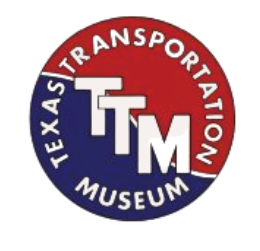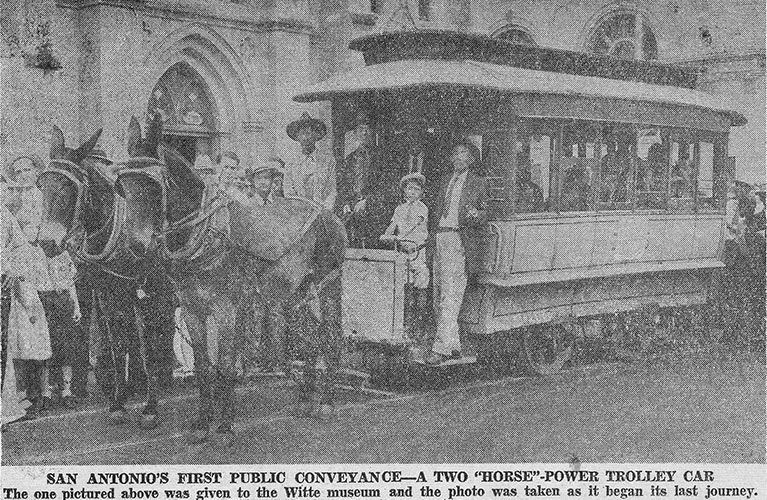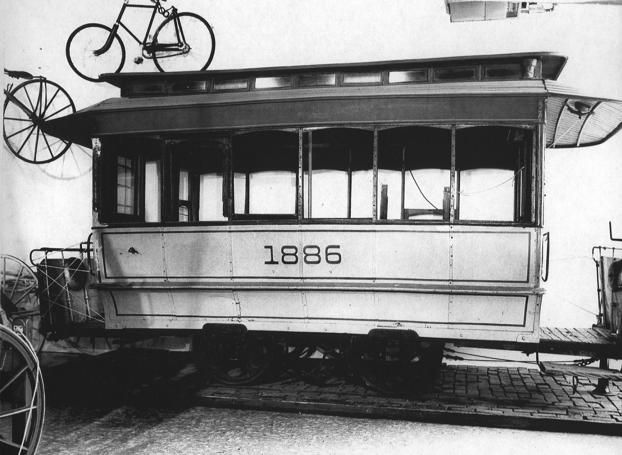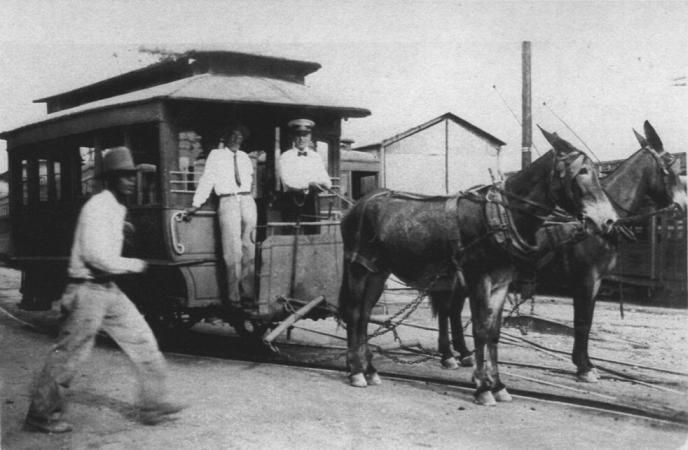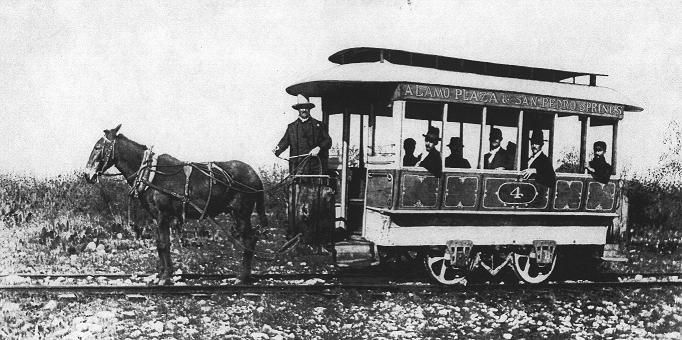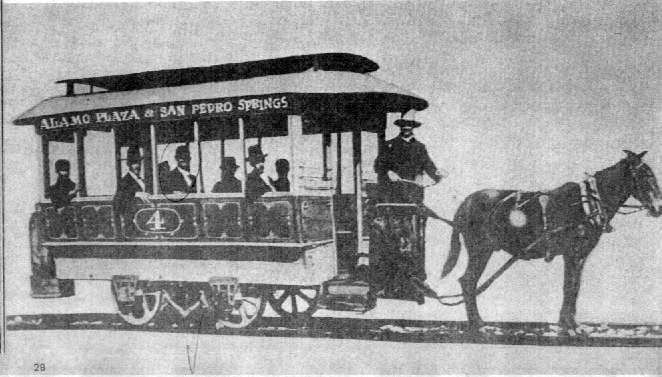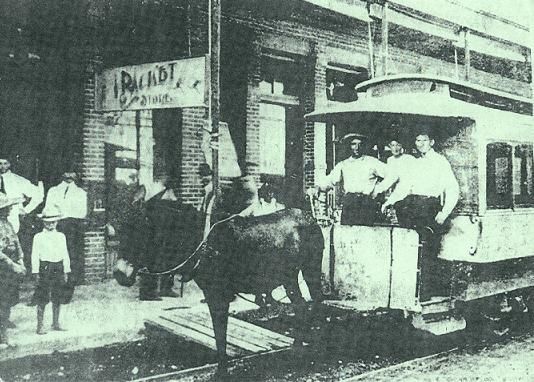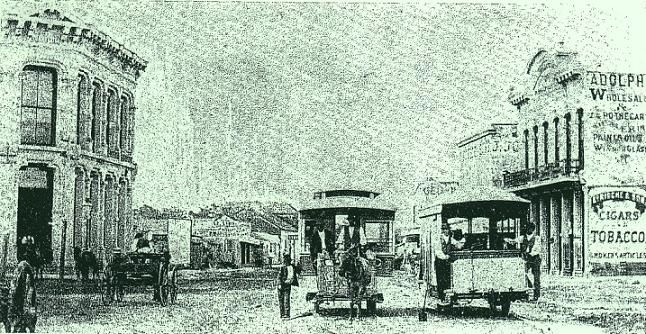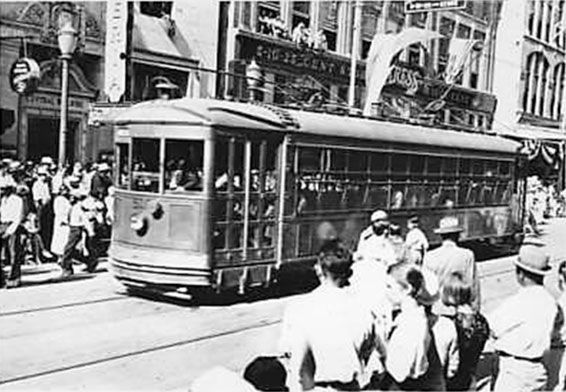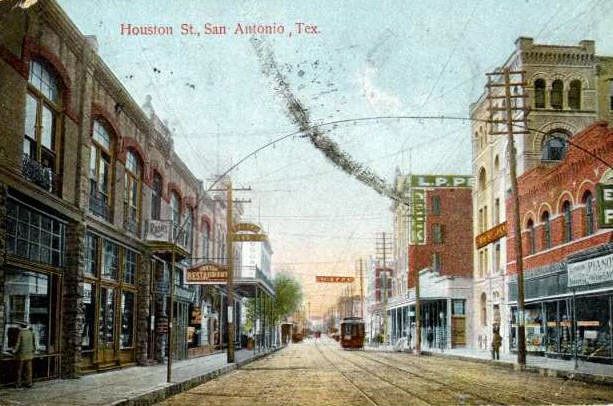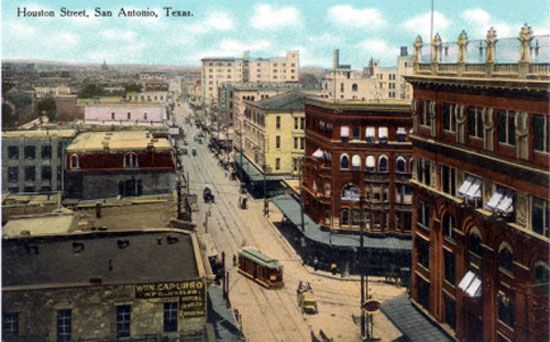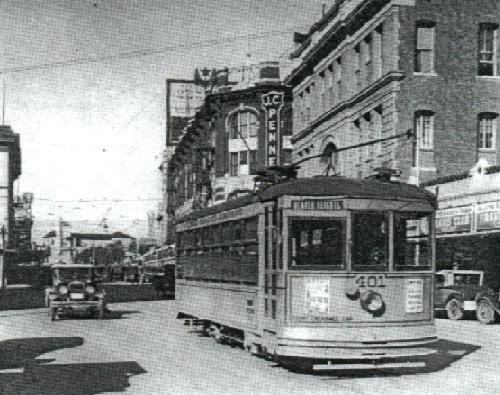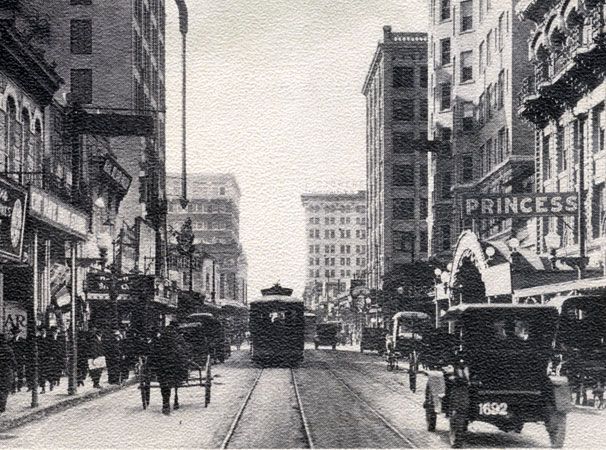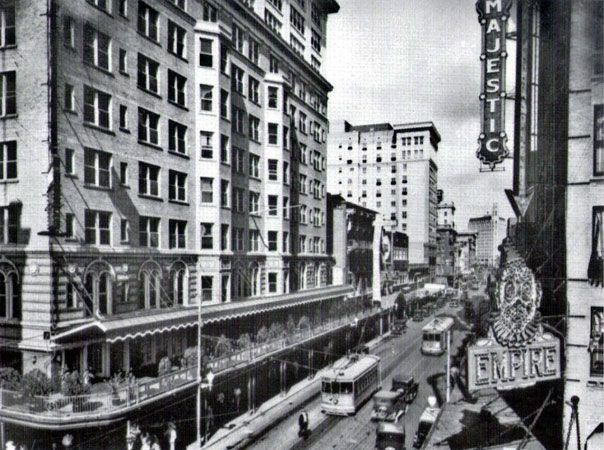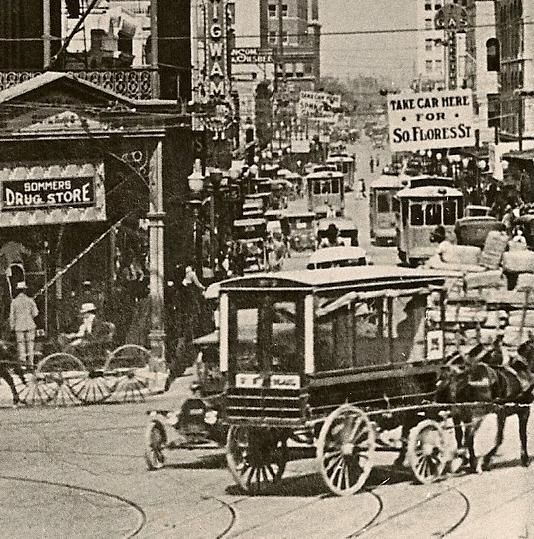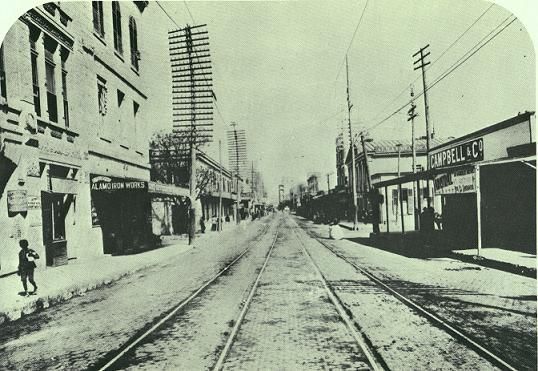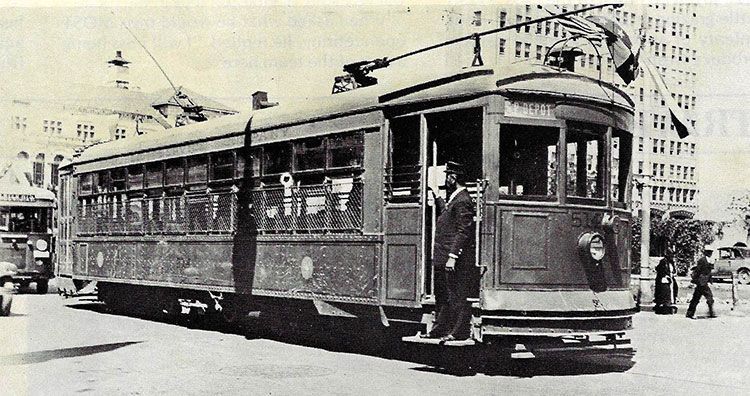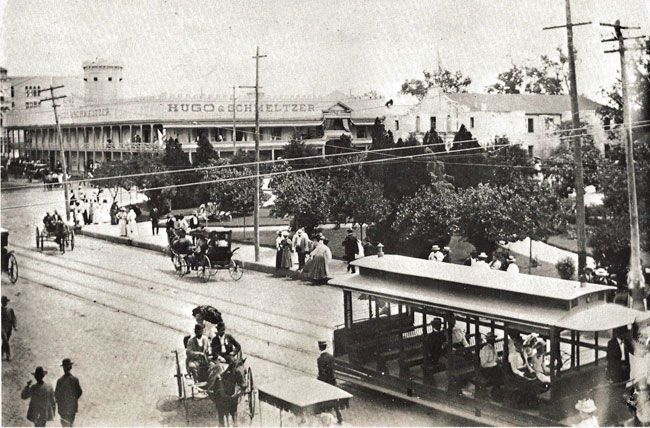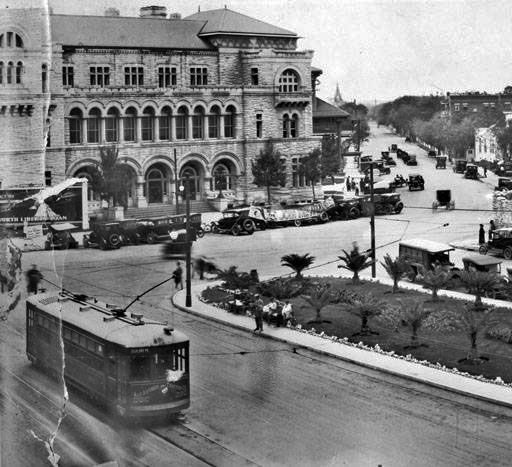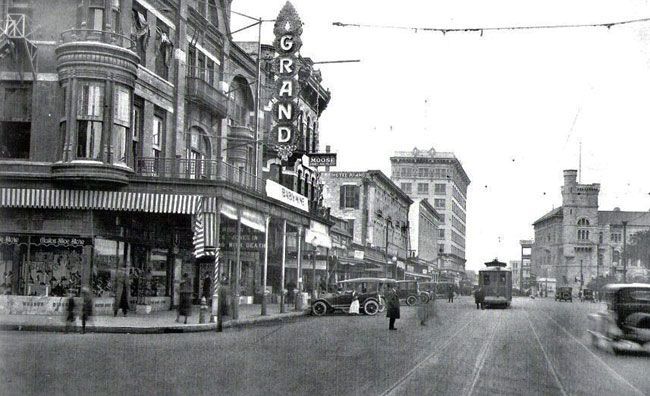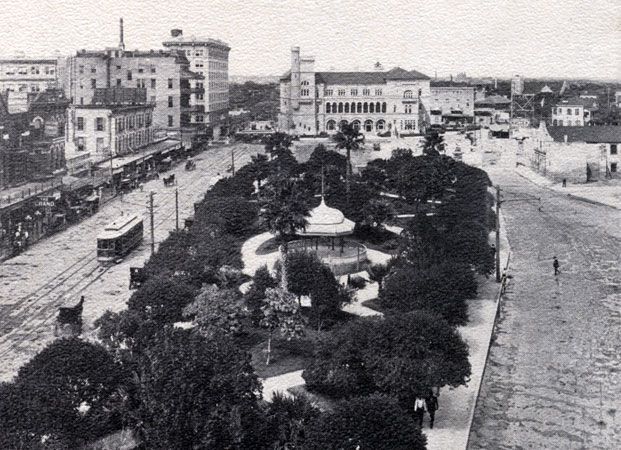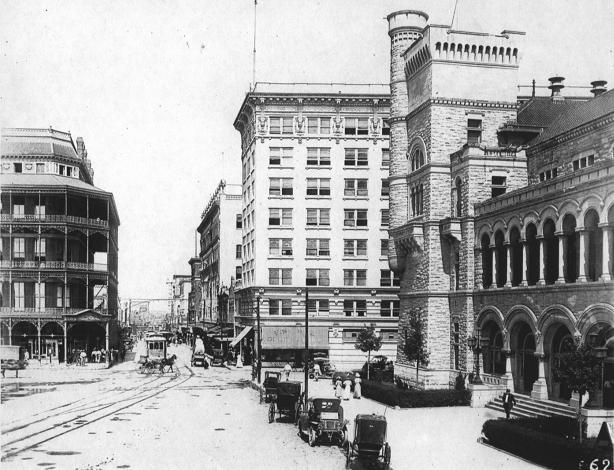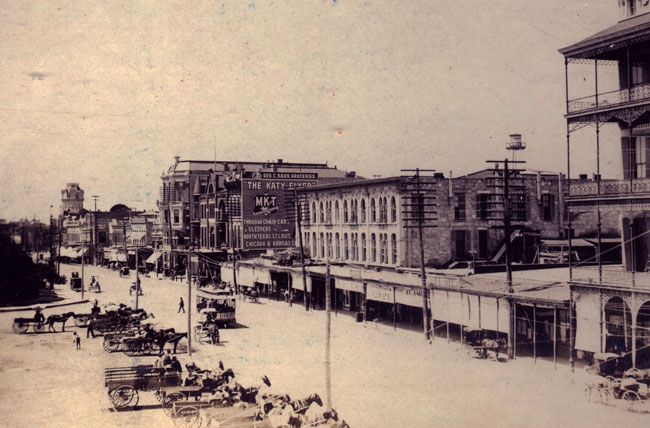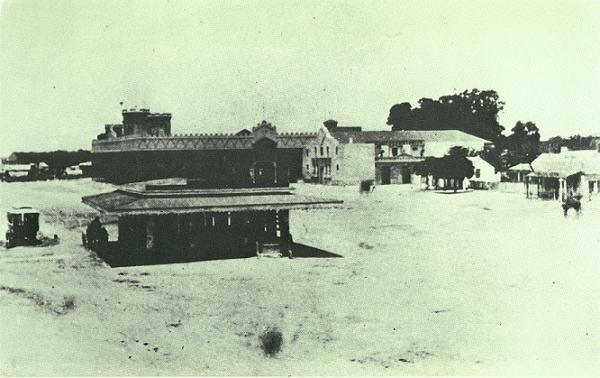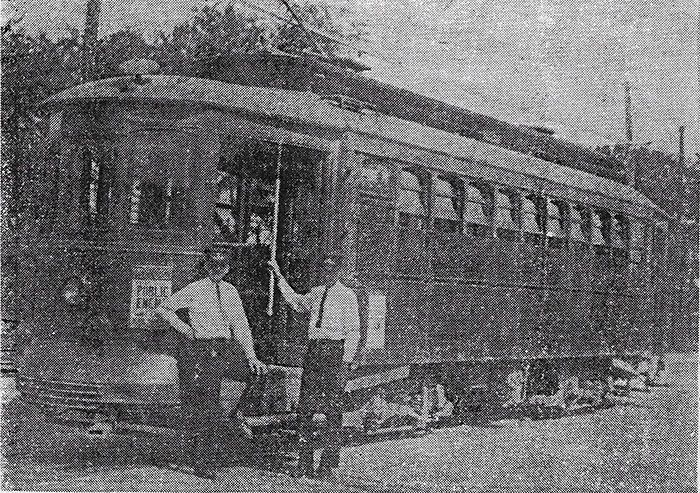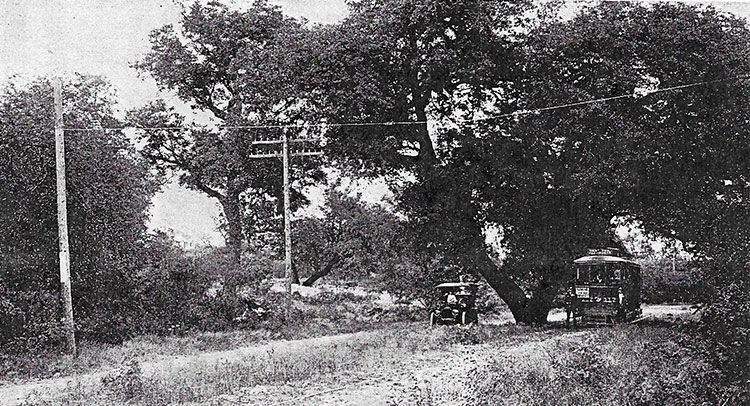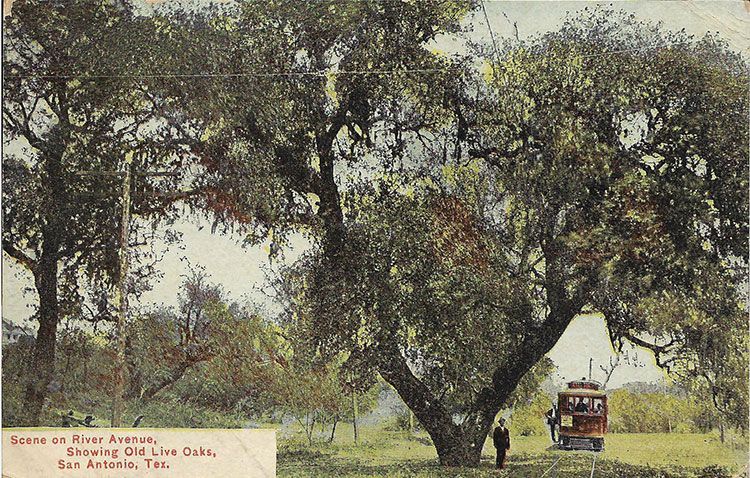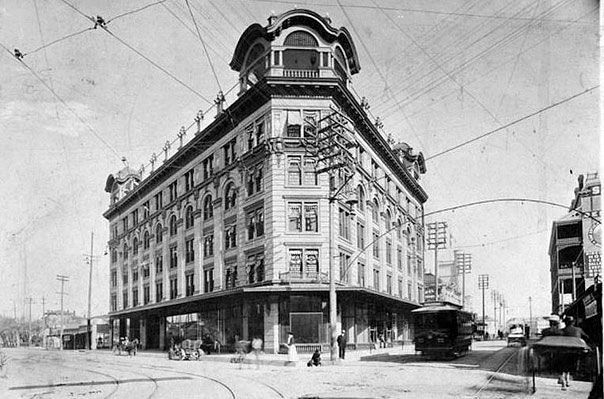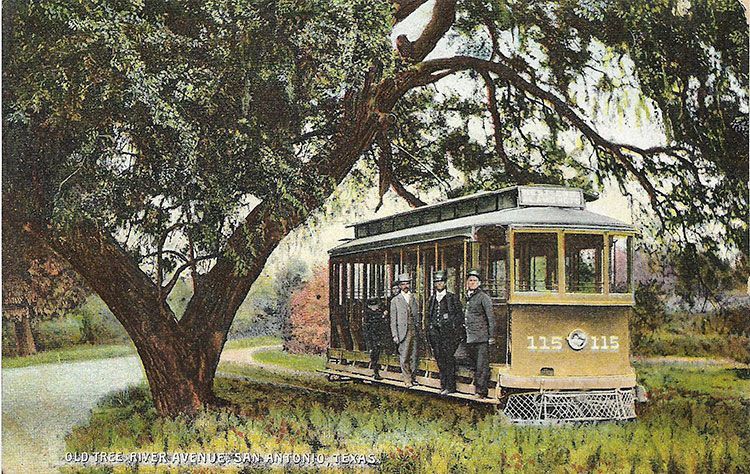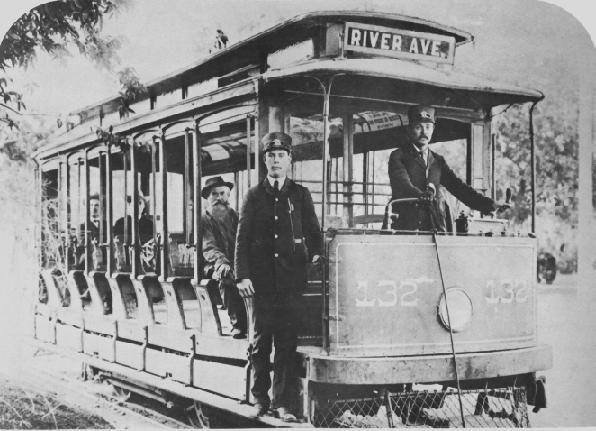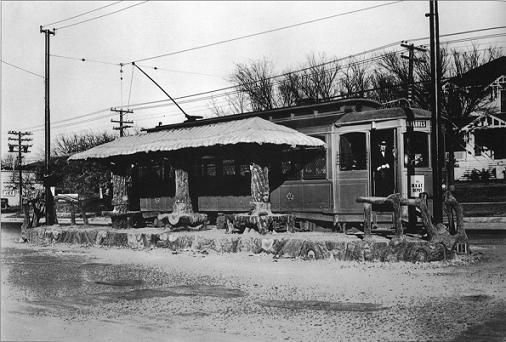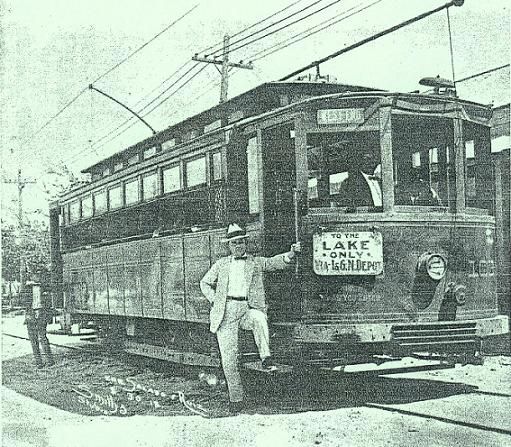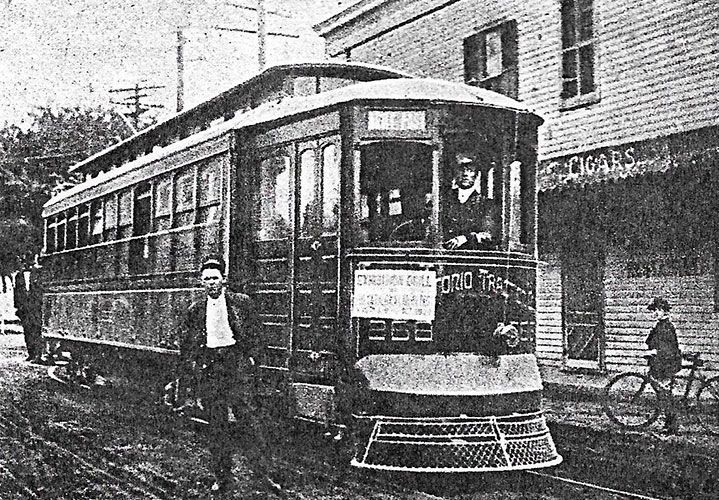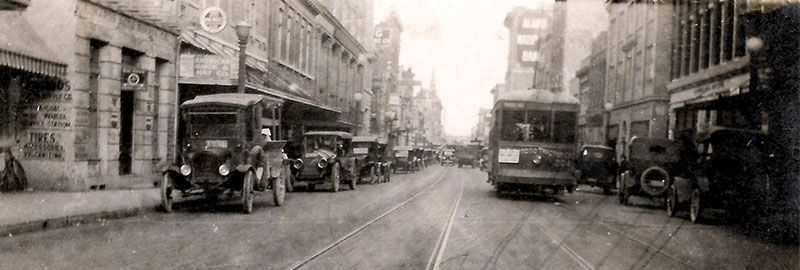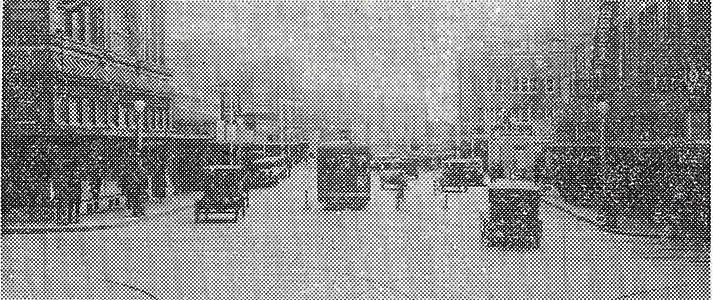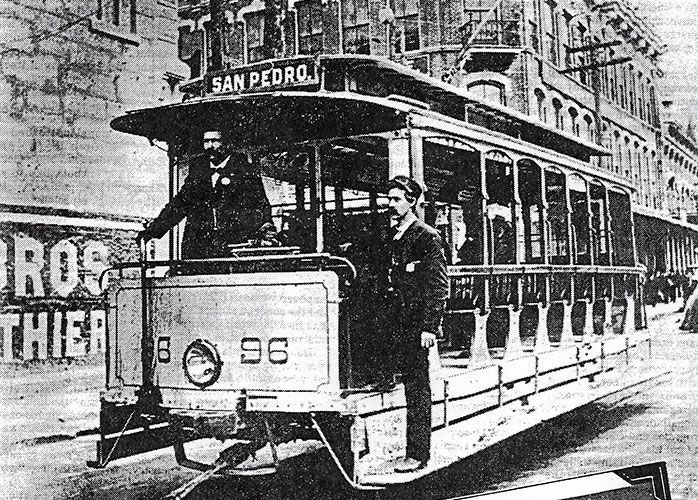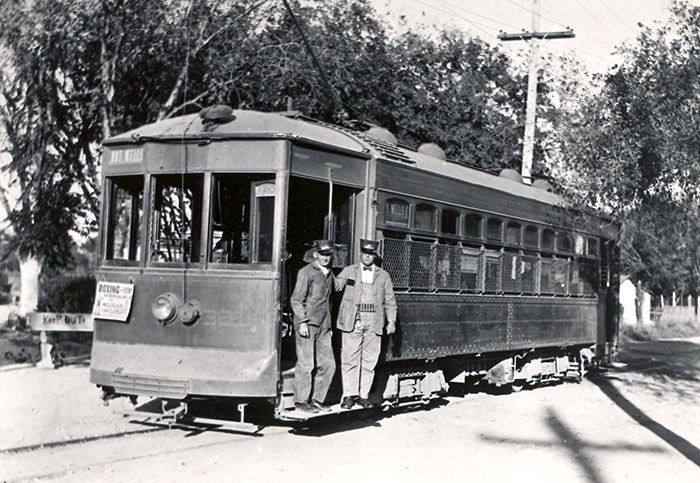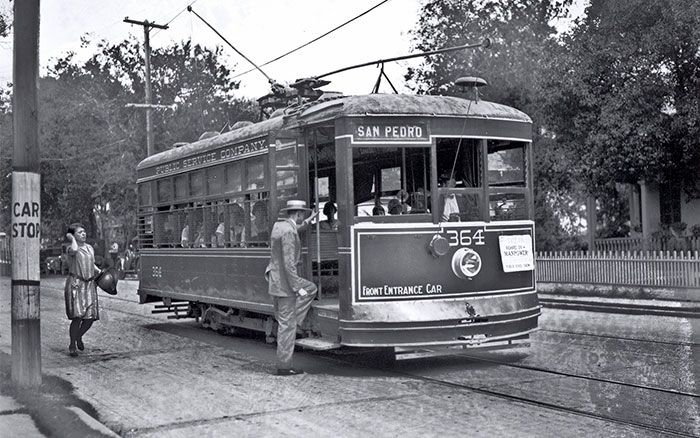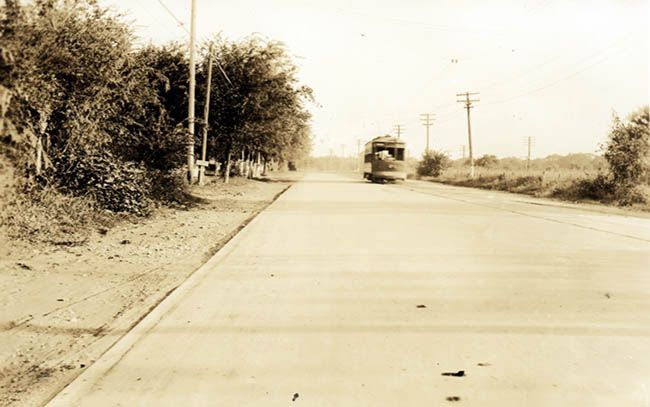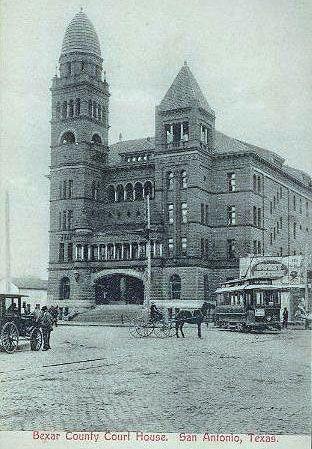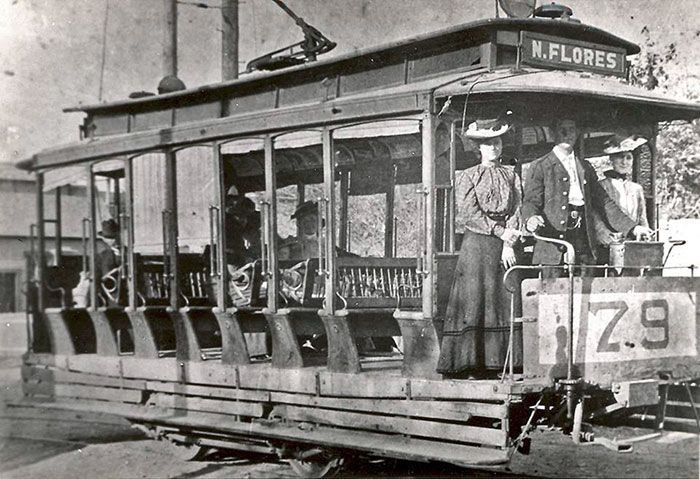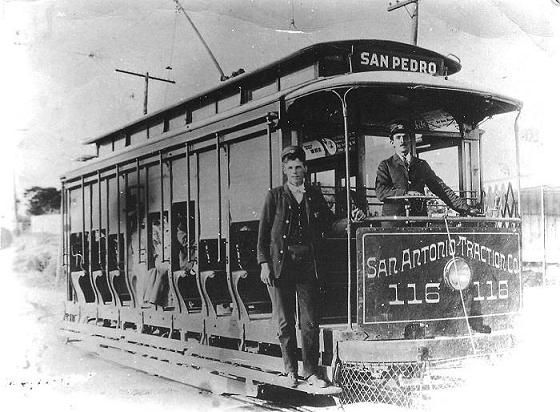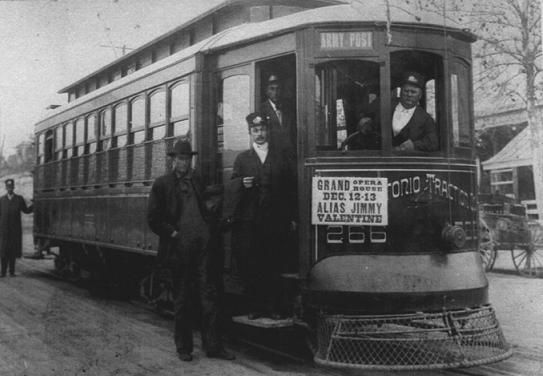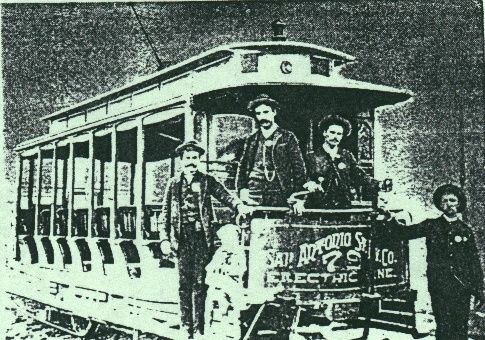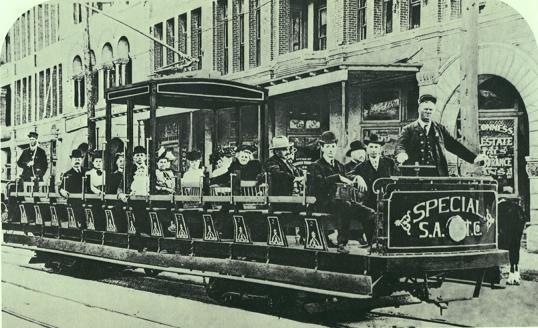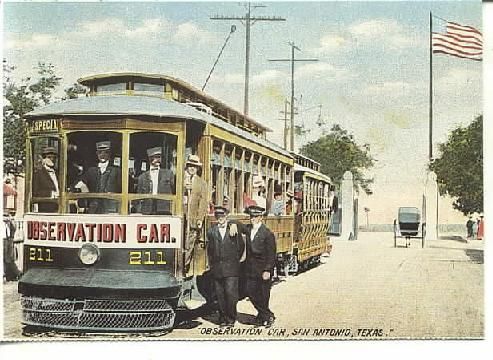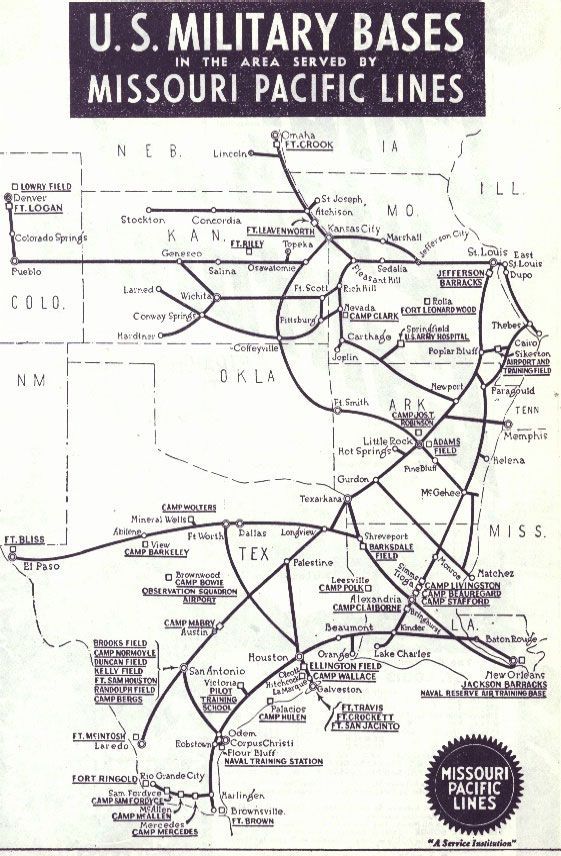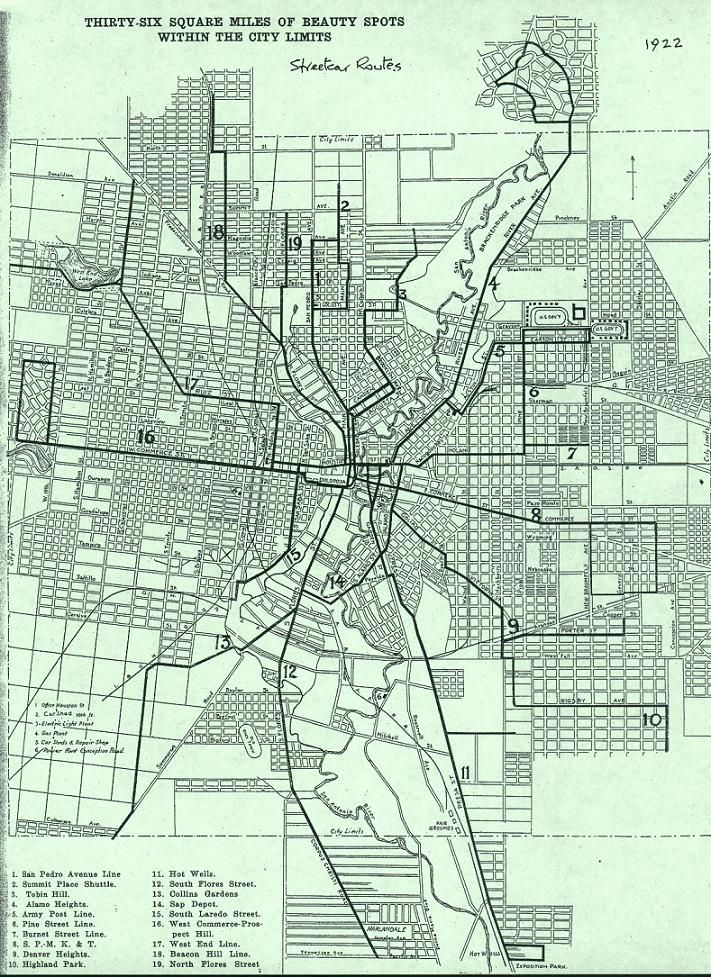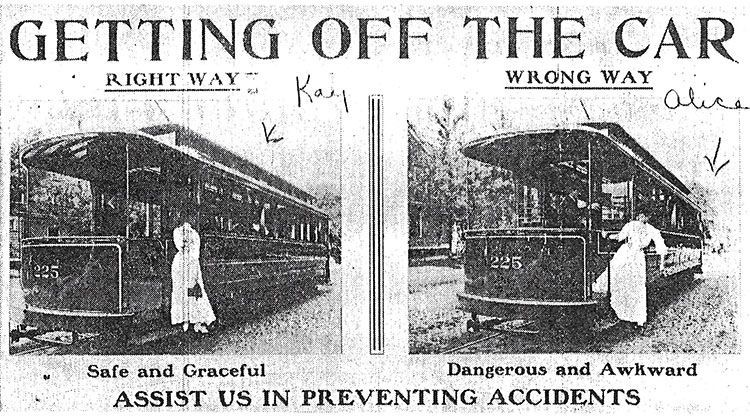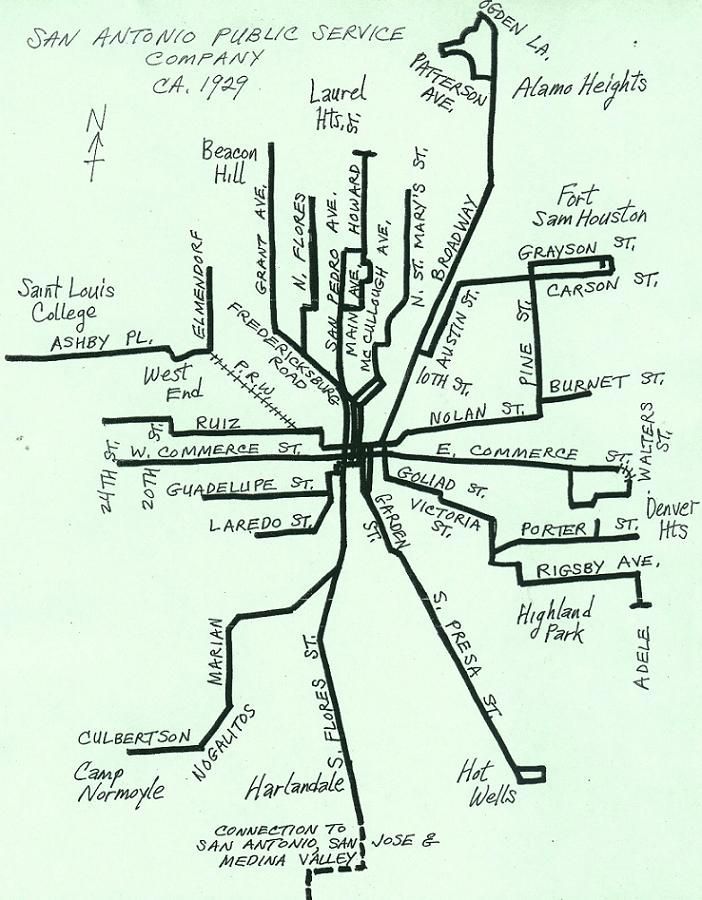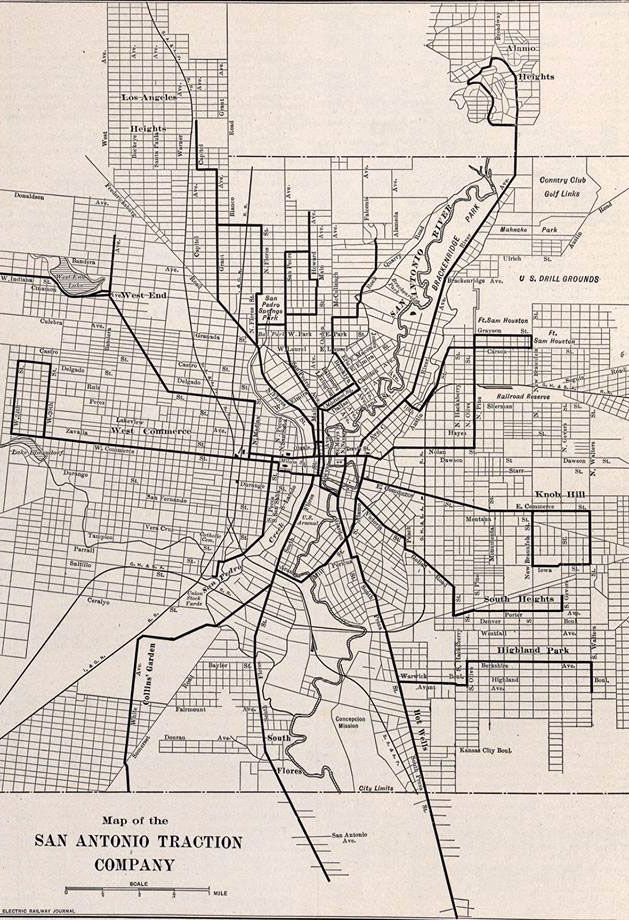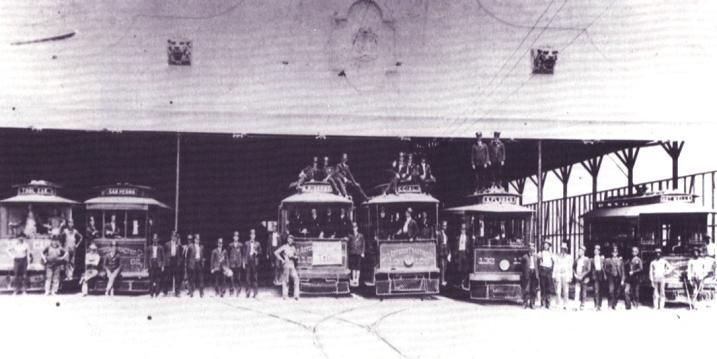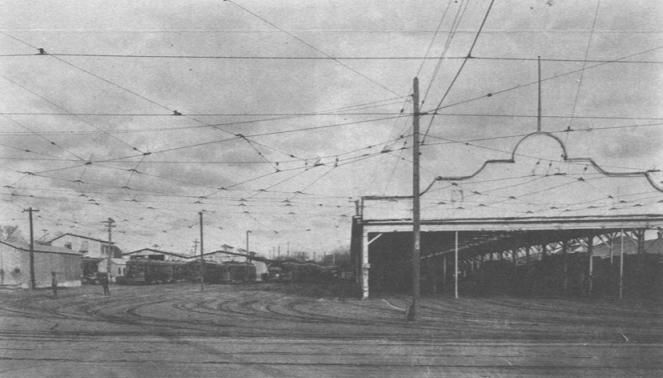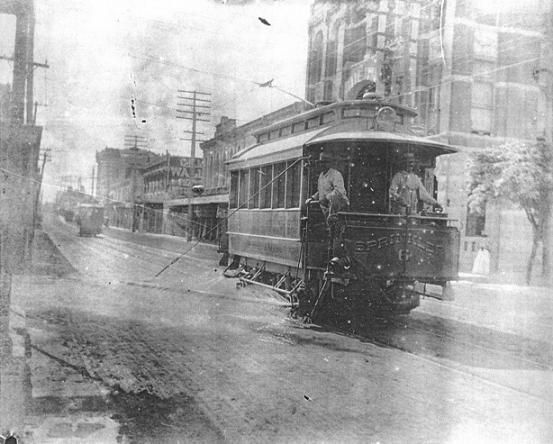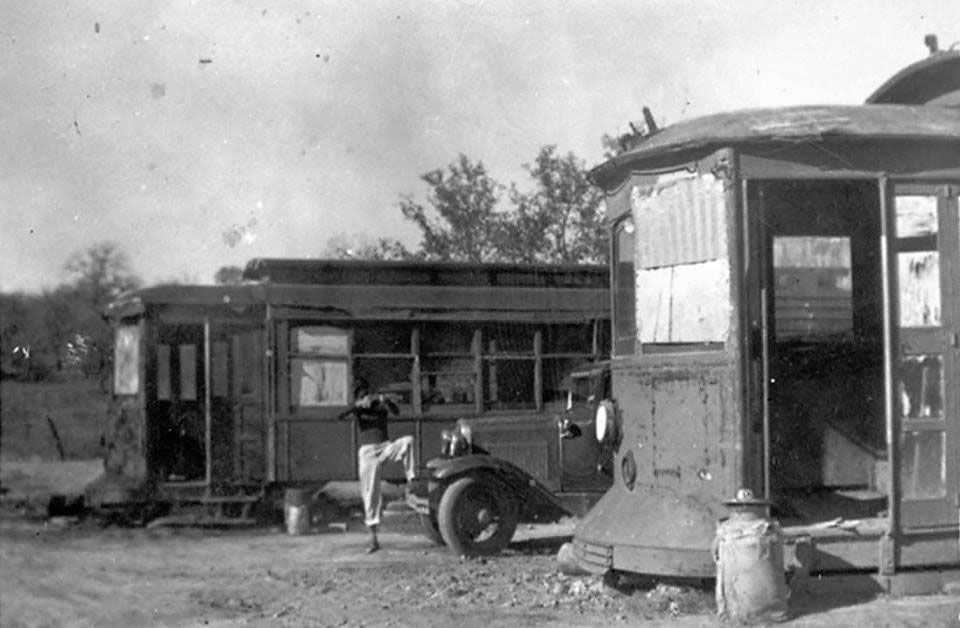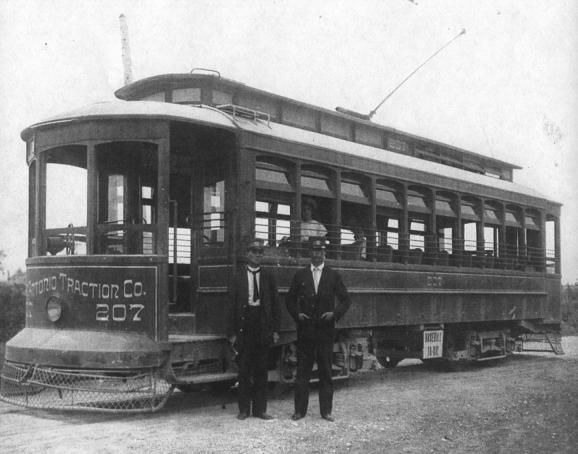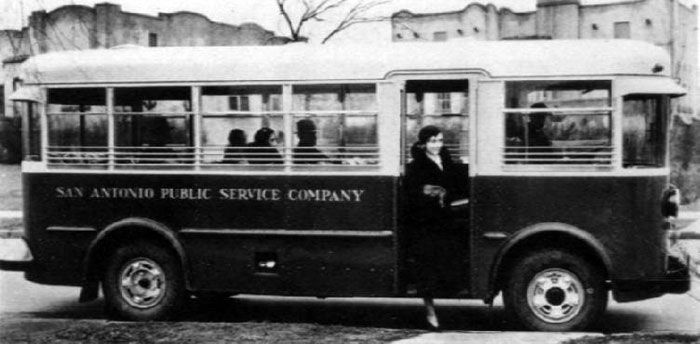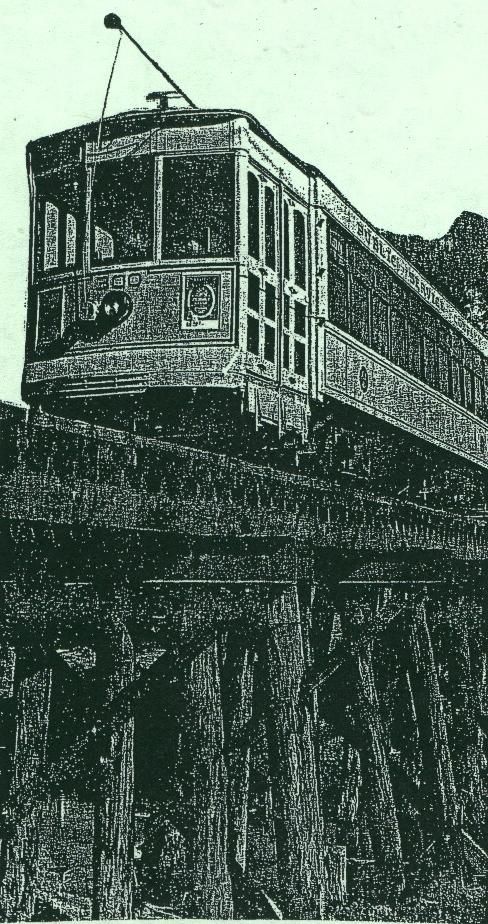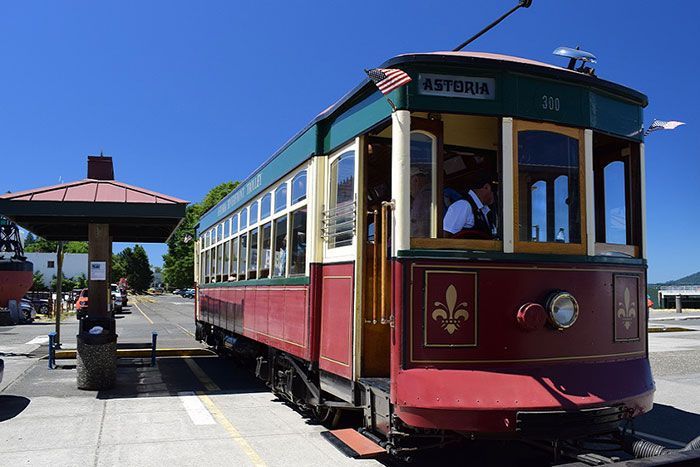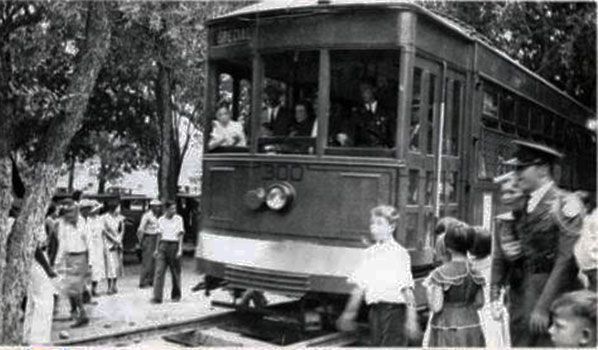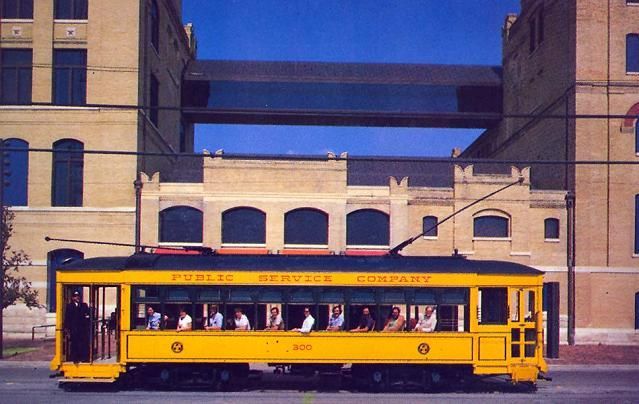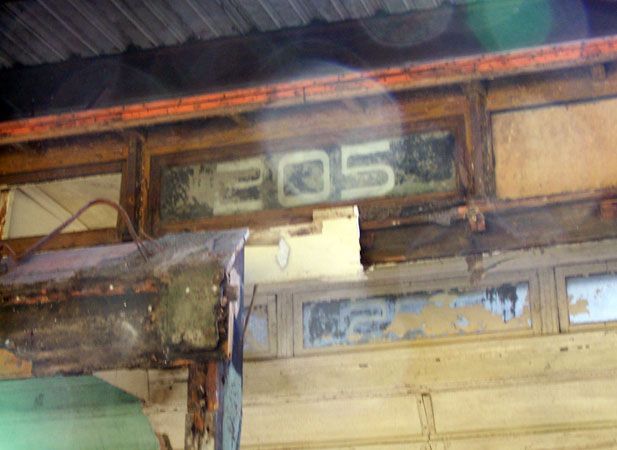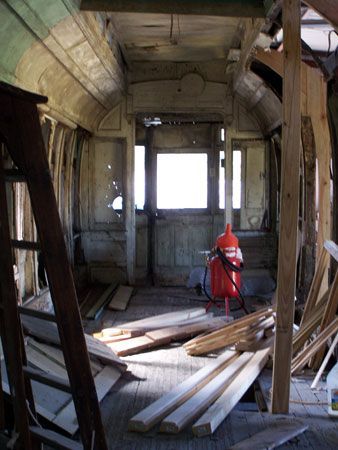Streetcars in San Antonio
Much of the information on this page was supplied by the US Army Medical Department Museum located at Fort Sam Houston, San Antonio. This museum is well worth a visit to get the fascinating story of how the military has always used forward thinking to make sure military and civilian personnel gets the best medical care available, often under the most difficult of circumstances.
Early mule drawn streetcars in San Antonio
San Antonio streetcar service began on June 27, 1878, just over one year after the first railroad, the Galveston Harrisburg & San Antonio, reached the city. The system would peak in 1926 at 90 miles of tracks. The cars were pulled by horses or mules until they were electrified in 1890. The very first route ran from Main Plaza to San Pedro Park. They would swap out mules at the terminus point. Mules had to be swapped out every mile when they pulled the older omnibuses along the unpaved roads since 1859. Soon an additional route was added, to the GH & SA railroad station located on North Austin Street and what is now known as Jones Street but was then called Grand Avenue for all the fancy houses that were built there after the tracks arrived. From Main Plaza you changed cars at the post office near the Alamo to go to the station. Real estate values soared along the line which traversed land which was essentially brush and scrub land until this time. Large lots that had struggled to get $75 - there wee only two houses built between downtown and San Pedro Park - soon were selling for around $500 and the area became the most desirable in the city. The first lines uses very lightweight rails and only thin wooden strip to keep them properly spaced apart, not actual heavy duty railroad ties. As a result, derailments were frequent. The system was soon called the GOP Line - Get Off and Push.
Streetcars on Houston Street, San Antonio
A major consequence of the new streetcar service was the development of Houston Street as the major shopping district in San Antonio. It used to be Commerce Street but the thoroughfare was too narrow, crooked and overcrowded to allow streetcars to be added. Houston Street, by comparison was brand new and undeveloped. Every line ran up and down its increasingly valuable length which was soon filled with gleaming high rise department stores of all kinds, Delivery was very popular back then before people had cars, so people could hop off the streetcar, do their shopping and return home very easily. Houston Street was one of the few places in the city that had double tracks, to allow travel in both directions. At the speed of a mule, hopping on and off became something of a pastime in itself. In 1881, a new line operated by a different company was built to serve the original International & Great Northern railroad station at the corner of Commerce Street and Medina. Passengers were taken right o the front door at junction with Houston Street. A line down South Flores Street to the San Antonio & Aransas Pass station at the junction with S. Alamo followed in 1884. San Antonio streetcars were electrified in 1890, following the completion of San Antonio's first large power generating station. Speeds doubled to 20 MPH and the cars doubled in size, from 16 seats to 32. The first run of an electric streetcar in San Antonio went from downtown to the International Fairgrounds - now Roosevelt Park - on September 26, 1890. Service to the Missouri Kansas & Texas station opened in 1917 had been easy to provide as it faced onto Flores at the corner of Durango, the same line that served the San Antonio & Aransas Pass railroad station.
Streetcars on Alamo Plaza, San Antonio
Initially the mule drawn service used open cars in the summer and more enclosed units in the winter but-following a state law banning open sided streetcars passed in 1905 all cars became enclosed. To begin with each line was run by a separate company but by 1891 these had been consolidated into just four organizations, The Bellknap, The McCrillis, the West End, and the Alamo Heights. The latter built a large maintenance facility near what is now San Antonio College on Broadway. Some of the newer lines were built using the stand 4 foot 8 1/2 inch width but the older companies used a narrow 4 foot gauge. However, it was not all plain sailing. In 1905, city newspaper editorials fumed that the frequent system outages were giving the city a bad reputation among tourists and citizens alike. Maintaining the system was very expensive and labor intensive. The companies also had to maintain any street they had tracks on. Making a profit for the privately owned company was always a challenge, especially as any rate increase had to be voted on by the city council.
San Antonio streetcars on River Avenue, Broadway and Alamo Heights
In 1901 the four remaining companies - there had already been several consolidations - were unified into the San Antonio Traction Company. A major benefit of this was that folks did not have to buy a separate ticket each time they switched cars. The concept of using different colors for each route, however, stayed in place for quite some time. The decision was made to reduce the standard gauge width of the newer lines to match the narrow gauge installed in heart of the system, which would continue to be the busiest, most used and most profitable part of the operation. By 1905 the increase in automobile ownership led to the paving of down town streets and the gradual disappearance of horse drawn wagons and carriages. Commerce Street street was widened in 1914 and streetcars could finally pass through, but by this time it had already become far less important to the daily commerce of the city. However it did allow better service to the Southern Pacific's Sunset Station, opened in 1901, which had had to rely on horse drawn omnibuses.
San Antonio Streetcars in various locations
The land at Leon Springs was formally acquired in 1908 and a small network of rails was created within the camp to cater to the quartermaster stores and the horse care facilities. The other two sites returned to civilian usage. Originally known as the Leon Springs Military Reservation, the camp was briefly known as Camp Funston before taking on its current name, Camp Stanley, in 1917. It was at this time that the training needs created by the rapid expansion of the army during World War One became an acute problem for the army. Once again the increasing range of military rifles and other weaponry necessitated the acquisition of even more land and more ranches to the south of the reservation were acquired. The new camp, named Camp Bullis, after the very successful Indian fighter, General John Bullis, stretched five miles south to the edge of Lockhill-Selma and the San Antonio & Aransas Pass railroad.
More San Antonio Streetcars
San Antonio's streetcar system reached its peak at ninety miles of track in 1926. But soon new communities, such as Terrel Hills and Olmos Park, were developed further and further away from the city center, in hilly areas unsuitable for streetcars. As the Great Depression hit, the declining amount of people still living in the downtown areas, where the bulk of the system's ridership always occurred, were less and less able to afford to buy tickets, and ridership declined. By this time the streetcars, which had no air-conditioning, had gained a reputation for being both slow and filled with unsavory passengers. SAPSCO's own buses were adding to the competition for longer range service. Buses were far cheaper to buy, operate and maintain, and far more flexible. Speed had become a crucial factor. In 1933, as land values in the city center fell as wealthier people moved away, often to unincorporated areas on the then outskirts of the city, tax revenue fell so badly that the city faced bankruptcy. SAPSCO offered $250,000 to the city for permission to abandon streetcars seven or eight years before its contract expired, allowing it focus exclusively on its more profitable bus service, and the offer was enthusiastically accepted. Streetcars were considered old and slow.
1924 San Antonio streetcar system map
This map representing the San Antonio streetcar and bus system in 1924 was made on behalf of the City Water Board, which itself was created in 1924. (It eveolved into SAWS in 1992.) Using a 1924 map and information supplied by TTM founding member John Kight, the map shows not only the streetcars but also the bus routes as well.
San Antonio Streetcar System Maps, PSA, Sheds and street-spraying work-car
Reading newspapers from the early 1930s, it is noticeable how few tears were shed when the streetcars went away. They were considered old, slow, expensive, unattractive and simply in the way of progress. They had gained a reputation for only carrying the least well off in the community and were shunned by most people who could afford an alternative. SAPSCO spent a fortune on paying the city to be allowed to abandon services about seven years before their service contract was due to expire. They also paid to either have the tracks covered over with asphalt or removed at junctions where they would have raised the road surface top high and the material become very prone to wearing away. SAPSCO also spent $400,000 on 65 new buses. Most could seat 20 people but there were some that could hold 30. The company's plan was to run small buses frequently and this proved to be very popular. In a time of economic hardship it made sense to take a bus. You could get were you needed to go quickly - and there was no additional fees to park a vehicle either, and no threat of it being broken into. Nostalgia is powerful, and tends to look back on the streetcar era as an idyllic time in the city's history. It certainly does not concern itself with balance sheets and other realities. Many people rue the day that the streetcars that served the city for 55 years were abandoned. Some indulge in conspiracy theories involving the "bad" General Motors Corporation and others, but the plain old balance sheet is actually where you need to look to see the major culprit. SAPSCO - then a private company - could not make money with streetcars and they could provide a faster, most reliable, less expensive and more popular service with buses. Times had changed.
The end of the line
One San Antonio streetcar not only survived, it was restored and returned to service, only not in San Antonio itself. "Old #300" was restored here in the late 1980s. It was hoped that it would be possible to recreate part of the lines from downtown to the San Antonio Art Museum but they didn't came to fruition. It is now in service in Astoria, Oregon. In stead of drawing power form over head lines, it pulls a small car behind it with a generator.
San Antonio Streetcar "Old 300"
In 2012, almost by accident, some Texas Transportation Museum volunteers stumbled onto this amazing barn find: old San Antonio streetcar 205 partially restored in a shed near Boerne. It was know a few old streetcars were rotting away in a field on the outskirts of the city but someone has taken it upon himself to try to save one of them. It is a tall order, to say the least. Basically made of wood every piece is either rotten or eaten away by wood worm. What little metal is there is almost completely rusted away. The fate of the car at this point is in the air as the purchaser recently died, leaving a significant question mark as to what happens next.
San Antonio Streetcar 205 in 2012
One San Antonio streetcar not only survived, it was restored and returned to service, only not in San Antonio itself. "Old #300" was restored here in the late 1980s. It was hoped that it would be possible to recreate part of the lines from downtown to the San Antonio Art Museum but they didn't came to fruition. It is now in service in Astoria, Oregon. In stead of drawing power form over head lines, it pulls a small car behind it with a generator.
San Antonio Streetcar Timeline
━━━━━━━━━━━━━━━━━
1874
The "San Antonio Street Railroad Company" is established.
━━━━━━━━━━━━━━━━━
1876
Work to build San Antonio's first streetcar line begins.
━━━━━━━━━━━━━━━━━
1878
In the planning stage for several years, mule drawn streetcars begin service from Alamo Plaza to San Pedro park and the new Southern Pacific railroad station.
━━━━━━━━━━━━━━━━━
1881
A line is laid to the new Missouri Pacific rail station at Commerce and Medina. Extensions further west follow as development of the area picks up around the depot.
━━━━━━━━━━━━━━━━━
1882
Denied access to Commerce Street because it was too narrow and crowded, all streetcars in the expanding system are routed along Houston Street which rapidly overtakes Commerce as the commercial and business hub of San Antonio.
━━━━━━━━━━━━━━━━━
1884
Streetcar service down South Flores to the San Antonio & Aransas Pass RR depot at the corner of what is now South Alamo begins. Work to lay tracks along E. Commerce Street begins.
━━━━━━━━━━━━━━━━━
1887
The West End Streetcar Co. was built to serve the newly developed areas surrounding the newly created West End Lake, now known as Woodlawn Lake.
━━━━━━━━━━━━━━━━━
1890
Following the electrification of the still growing system, streetcars become bigger and faster, allowing them to carry more people longer distances allowing even more expansion. Away from the city center the electric days were allowed to go at 20 MPH, twice that of the mule drawn cars. Some of the newer lines had to be reduced from 4 feet 8 ½ inches, what is known as standard width to the narrower four feet of the older tracks.
━━━━━━━━━━━━━━━━━
1891
Fully enclosed cars are introduced to protect passengers from dust and adverse weather. Some open cars are used only during the summer months for tourist lines.
━━━━━━━━━━━━━━━━━
1901
The streetcar network which had already evolved from one company per line radiating from the city center to four larger companies is consolidated into just one organization, the San Antonio Traction Company.
━━━━━━━━━━━━━━━━━
1903
A case involving the mandated obligation upon streetcars to offer half priced tickets to school children during terms was taken all the way to the Supreme Court. SAPSCO lost.
━━━━━━━━━━━━━━━━━
1905
Streetcar companies become responsible for one third of the cost of improving the streets it runs along. Improvements included widening, which might mean relocating the tracks to stay in the center.
━━━━━━━━━━━━━━━━━
1917
SAPSCO, the San Antonio Public Service Company is formed with the unification of the San Antonio Traction Company and the San Antonio Gas and Electric Company, which is part of the nationwide Edison group of companies.
SAPSCO begins limited bus service, with vehicles built in its own shops based on rudimentary truck chassis, to and from Fort Sam Houston, which has never allowed streetcars onto the vast military facility.
━━━━━━━━━━━━━━━━━
1921
A court case resulting from the denial by the City of San Antonio of a SAPSCO fare hike of just one cent to six cents went all the way to the Supreme Court. This time SAPSCO won.
━━━━━━━━━━━━━━━━━
1923
SAPSCO acquires its first factory built buses. At first it uses them to serve outlying areas and areas that were not served by streetcars but passenger demand soon leads them to be used along the same streets and roads.
━━━━━━━━━━━━━━━━━
1926
The streetcar system in San Antonio reaches its peak of 90 miles of tracks.
━━━━━━━━━━━━━━━━━
1928
SAPSCO is operating 135 streetcars and 74 buses.
━━━━━━━━━━━━━━━━━
1933
Having found streetcars, with their tracks and overhead power lines to expensive to operate in comparison with cheaper and more flexible buses, SAPSCO pays the city $250,000.00 to be able to quit using them seven years before their contract expires, becoming the first major city in the USA to go over buses completely. As such contracts expired in Austin, Houston, Fort Worth and Dallas, and other cities, they were withdrawn there in due course.
Transportation Museum
CONTACT US TODAY
Phone:
210-490-3554 (Only on Weekends)
Email:
info@txtm.org
Physical Address
11731 Wetmore Rd.
San Antonio TX 78247
Please Contact Us for Our Mailing Address
All Rights Reserved | Texas Transportation Museum
